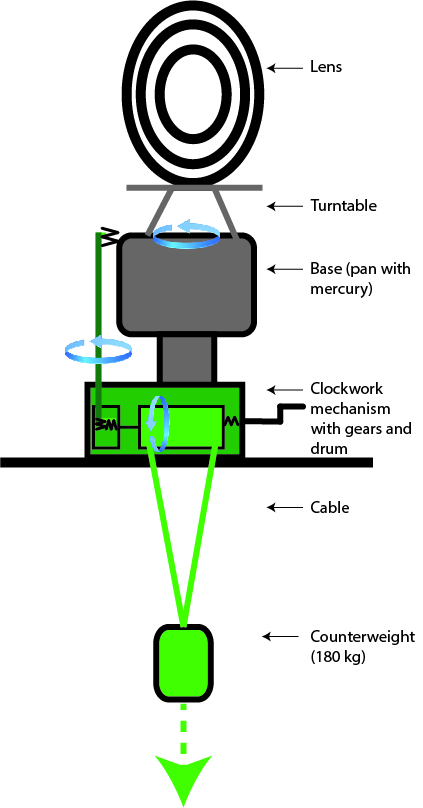HOW THE LIGHTHOUSE WORKS
Making the Lighthouse Visible
The Fresnel Lens magnifies and concentrates the light into a single, powerful, but narrow, beam. However, this beam of light is only visible to someone who is directly in its path so, for the light to be visible in all directions, the entire lens, including the base on which it is mounted, must rotate 360˚. At the outset, before there was power to the site, this rotation was achieved by using gravity, a heavy weight, and a clockwork mechanism.
A 180 kg (400 lb) weight, attached to a cable wrapped around a drum is released at the top of the lighthouse. As it slowly falls through the entire length of the tower, the cable unwinds and turns the drum. The drum is attached to a series of gears that govern its tension and the speed at which it falls, and the gears in turn are attached to cogs in the turntable to which the lens is attached, thus causing the entire lens structure to rotate.
At Sheringham Point, it would take about 3 hours for the weight to reach the bottom of the tower, at which time it would have to be cranked back up to the top and the process started again. Originally this was done by hand, and in later years by an attached electric motor.
Because of the tremendous weight of the lens (2 tonnes), for it to rotate smoothly the friction had to be reduced. This was accomplished by floating the entire lens in a bed of liquid mercury (contained in the large pan beneath the lens).

How Far Can the Light Be Seen?
This depends on several factors. Obviously, the weather affects visibility. Also, the power (intensity) of the light itself is a limiting factor. But assuming it’s a clear night, and the lighthouse is powerful enough, the visible distance is also governed by its height above sea level. This is due to the curvature of the earth. A light at 2m (6ft) above sea level, even a powerful one, can only be seen for 5 km (3 miles). Beyond that, it is below the horizon. So, the higher the light is above sea level, the further it can be seen.
Sheringham Point’s light is approximately 26.5 m (87 ft) above sea level, so it can be seen by ships approximately 28 km (17.5 miles) away in good weather.
And that’s why lighthouses are so tall.
The Lighthouse "Signature"
When a captain of a vessel sees a light or hears a foghorn how does he know which lighthouse it is?







